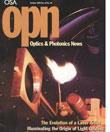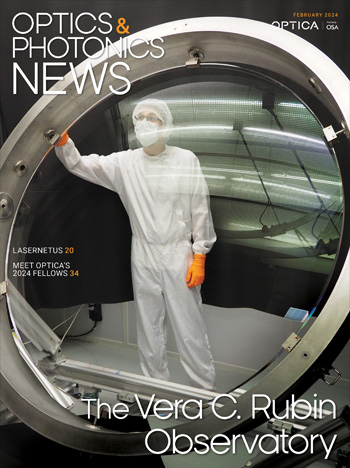
October 1999 Issue
Feature Articles
Chromatic Aberrations
When light is refracted at an optical surface, light of different wavelengths are bent different amounts because the velocity of propagation varies with wavelength. This variation is called dispersion. For any simple lens, dispersion causes slightly different focal distances for each color. If an object is white (composed of all colors), the red component will come into focus at a different place from the blue component.
by Bob D. GuentherThe Evolution of a Laser Artist
Washington D.C. artist Rockne Krebs pioneered the use of lasers as an art form. Here is the story of his passion for color and light.
by Jennifer M. RiceIlluminating the Origin of Light Guiding
John Tyndall usually gets credit for inventing light guiding by total internal reflection; but, the now forgotten Daniel Colladon demonstrated the concept over a dozen years earlier.
by Jeff HechtHigh Performance Quantum Cascade Lasers
A fundamentally new laser holds promise for high-resolution spectroscopy and applications ranging from chemical sensing to light-wave communications.
by Federico Capasso, Claire Gmachl, Alessandro Tredicucci, Albert L. Hutchinson, Deborah L. Sivco, and Alfred Y. ChoThe Van Leeuwenhoek Microscope
Antoni van Leeuwenhoek (1632-1723), a fabric merchant from Delft, the Netherlands, used tiny glass spheres to study various microscopic objects at high magnification with surprisingly good resolution. A contemporary of Sir Isaac Newton, Christiaan Huygens, and Robert Hooke, Van Leeuwenhoek is said to have made over 400 microscopes and bequeathed 26 of them to the Royal Society of London. (A handful of these microscopes are extant in various European museums.) Using his single-lens microscope, Leeuwenhoek observed what he called animalcules—or microorganisms, to use the modern terminology—and made the first drawing of a bacterium in 1683. He kept detailed records of what he saw and wrote about his findings to the Royal Society of London and the Paris Academy of Science. His contributions have made him the father of scientific microscopy.
by Masud MansuripurDiffractive Apochromatic Double-Gauss Lens
Large-aperture double-Gauss lenses normally employ high-index lanthanum crown glasses in the positive elements in order to minimize field curvature and spherical aberration. However, the partial dispersion characteristics of these glasses is similar to the short flint types (KZF, KZFS, etc.), and thus departs from the "normal" glass line in a direction opposite to that required for secondary color correction. The resulting exaggerated secondary spectrum limits the axial performance in otherwise well-corrected large aperture double-Gauss photographic lenses.
by J. Brian Caldwell
![A multiplexed image of a human tonsil acquired. [NIAID] using the iterative bleaching extends multiplexity (IBEX) method.](https://opnmedia.blob.core.windows.net/$web/opn/media/images/articles/2024/0424/departments/202404-cover-web.jpg?ext=.jpg)

